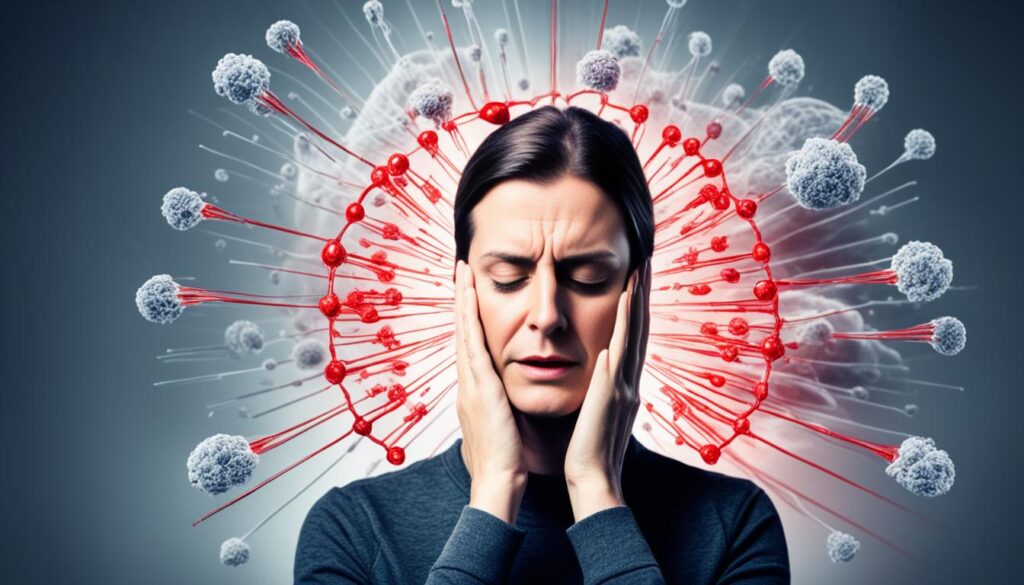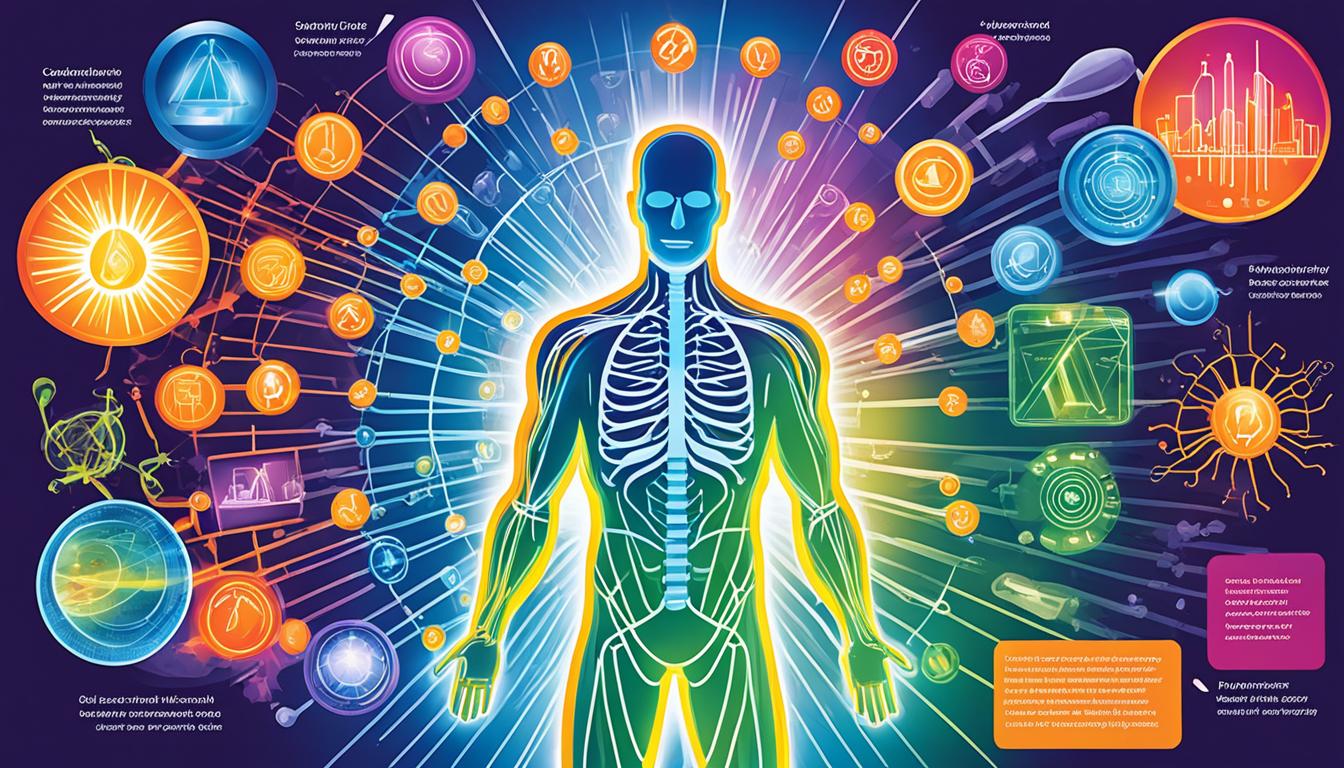Disclosure: This Post Contains Affiliate Links; We earn a commission on purchases.
The fifth-generation cellular network, known as 5G, has raised concerns among the population regarding potential health impacts from exposure to 5G radio frequency radiation (RFR). However, regulatory authorities such as the International Commission on Non-Ionizing Radiation Protection (ICNIRP) and the Federal Communications Commission (FCC) have established guidelines to limit the maximum allowable RF exposure. While there is a debate about the long-term non-thermal health impacts of 5G, no adverse effects have been proven for exposure within regulatory limits.
Despite the buzz surrounding 5G radiation dangers, it is important to separate fact from fiction. In this article, we will explore the risks of 5G EMF exposure and examine the scientific evidence behind the concerns. By understanding the potential health effects of 5G and EMF exposure, we can make informed decisions about our own well-being.
Key Takeaways:
- 5G radiation dangers have sparked concerns about potential health effects.
- Regulatory authorities have established guidelines to limit maximum RF exposure.
- No adverse effects have been proven for exposure within regulatory limits.
- Scientific evidence does not support claims of significant health risks from 5G EMF exposure.
- The debate continues regarding the long-term non-thermal health impacts of 5G.
Introduction to 5G and EMF Exposure
The fifth generation of mobile technologies, 5G, is an evolution of previous generations like 2G, 3G, and 4G. It supports applications such as smart homes, self-driving cars, remote medical services, and more. Mobile technologies, including 5G, use electromagnetic fields (EMFs) to transmit information. EMFs are categorized into ionizing and non-ionizing, with 5G operating on non-ionizing frequencies. There is no evidence that existing mobile networks pose health risks below the levels specified by international bodies.
5G technology has the potential to revolutionize various industries and enhance connectivity worldwide. However, concerns have been raised regarding the electromagnetic frequency hazards and cell phone radiation risks associated with 5G EMF exposure. In this section, we will explore the fundamentals of 5G technology and its relationship to EMF exposure.
What is 5G Technology?
5G is the fifth generation of mobile network technology that allows for faster and more reliable wireless communication. It promises to deliver higher data rates, lower latency, and greater capacity compared to its predecessors. With its increased bandwidth capabilities, 5G enables the seamless integration of advanced technologies such as the Internet of Things (IoT), augmented reality (AR), and virtual reality (VR).
5G networks operate on higher radio frequencies to accommodate the growing demand for data-intensive applications. These frequencies fall within the non-ionizing range of the electromagnetic spectrum, which is considered safe for human exposure.
Understanding Electromagnetic Fields (EMFs)
Electromagnetic fields (EMFs) are areas of energy produced by electromagnetic radiation. They can be found in various forms, such as radio waves, microwaves, and visible light. EMFs are classified into two categories: ionizing and non-ionizing.
- Ionizing EMFs: These EMFs have enough energy to remove tightly bound electrons from atoms or molecules, causing ionization. Examples of ionizing radiation include X-rays and gamma rays. Prolonged exposure to ionizing radiation is known to have harmful effects, including an increased risk of cancer.
- Non-ionizing EMFs: These EMFs have lower energy levels and do not possess enough power to ionize atoms or molecules. Non-ionizing radiation includes radiofrequency waves, which are utilized by mobile technologies like 5G. Extensive research suggests that non-ionizing EMFs do not cause DNA damage or increase the risk of cancer.
It is crucial to differentiate between ionizing and non-ionizing EMFs, as they have vastly different health effects. The electromagnetic fields used in 5G networks fall into the non-ionizing category and are considered safe for human exposure within regulatory limits.
Regulatory Guidelines and Safety Measures
To ensure public safety, regulatory bodies around the world have established guidelines and exposure limits for EMFs. These guidelines are designed to protect individuals from potential health hazards associated with EMF exposure. Organizations such as the International Commission on Non-Ionizing Radiation Protection (ICNIRP) and the Federal Communications Commission (FCC) have set strict standards for the emission levels of electromagnetic radiation from mobile devices and networks.
\”There is no convincing evidence that exposure to radiofrequency (RF) fields from mobile phones or base stations causes adverse health effects.\” – World Health Organization (WHO)
Consequently, the current scientific consensus is that exposure to non-ionizing radiation emitted by 5G networks does not pose significant health risks when adhering to regulatory limits.
Understanding EMFs and Radiation
Electromagnetic fields (EMFs) are areas of energy caused by electromagnetic radiation being emitted. EMFs can be categorized into two types: ionizing and non-ionizing. Non-ionizing EMFs are the type used in mobile technologies, including 5G. The distinction between ionizing and non-ionizing radiation is important when considering health and safety implications. Ionizing radiation, such as that emitted by X-rays and nuclear power plants, is known to increase the risk of cancer.
5G operates on non-ionizing frequencies and has not been proven to pose the same health risks as ionizing radiation. The current limits on radiofrequency energy set by regulatory bodies, such as the International Commission on Non-Ionizing Radiation Protection (ICNIRP) and the Federal Communications Commission (FCC), are considered acceptable for protecting public health.
| Type of EMF | Risk |
|---|---|
| Ionizing (X-rays, nuclear power plants) | Increased risk of cancer |
| Non-ionizing (5G, cell phones) | No proven adverse health effects within regulatory limits |
It is important to note that while some people may have concerns about the safety of 5G and EMF exposure, scientific research and regulatory guidelines support the notion that exposure within the specified limits does not pose significant health risks. Continued monitoring and research are essential to ensure the ongoing safety of wireless technologies and to address any potential concerns that may arise.

References:
- International Commission on Non-Ionizing Radiation Protection (ICNIRP)
- Federal Communications Commission (FCC)
Debunking Misinformation and Hoaxes
The rollout of 5G has sparked numerous misinformation and conspiracy theories, with some claiming that 5G technology is responsible for the spread of COVID-19. However, these theories lack scientific evidence and are biologically impossible. Despite the concerns raised, exposure to 5G radiation within regulatory limits has not been proven to have any adverse effects on human health.
Various studies have been conducted to investigate the potential health impacts of 5G electromagnetic field (EMF) exposure, but it is important to note that most of these studies have methodological issues that hinder the accurate assessment of carcinogenicity. While it is crucial to continue researching the effects of EMFs on human health, the current scientific consensus affirms that the exposure to 5G radiation, within the established limits, does not pose significant risks.
“The exposure to 5G radiation within regulatory limits has not been proven to have adverse effects on human health.”
It is essential to rely on reputable sources and scientific studies when evaluating the potential risks and effects of 5G EMF exposure. Despite the unsubstantiated claims and misinformation circulating, regulatory authorities and international organizations such as the World Health Organization (WHO) continue to affirm the safety of 5G technology.
Addressing the Concerns
One of the primary concerns surrounding 5G and EMF exposure is the fear of increased cancer risk. However, extensive research has indicated that non-ionizing radiation, such as that emitted by 5G networks, does not possess sufficient energy to damage DNA or cause cancer.
Additionally, claims that 5G technology causes cellular stress, genetic damage, or neurological disorders are also lacking scientific evidence. The overwhelming consensus among experts is that the exposure to 5G EMFs within regulatory limits poses minimal to no risk to human health.
The Role of Misinformation
The proliferation of misinformation regarding 5G and EMF exposure has been fueled by sensationalized news articles, social media platforms, and online conspiracy theories. It is crucial for individuals to critically evaluate information and rely on trusted sources of scientific research to make informed decisions.
“Despite the unsubstantiated claims and misinformation circulating, regulatory authorities and international organizations such as the World Health Organization (WHO) continue to affirm the safety of 5G technology.”
By addressing misconceptions and providing accurate scientific information, it is possible to counteract the spread of fear and misinformation surrounding 5G and EMF exposure. Continued education, research, and open dialogue are key to ensuring public understanding and acceptance of this transformative technology.
Potential Health Impacts of 5G Technologies
While 5G technology continues to evolve and shape our increasingly connected world, concerns have been raised regarding its potential health impacts. Some experts point to the lack of long-term studies and the concentration of 5G in populated areas as reasons for caution.
The genetic effects of exposure to electromagnetic fields (EMF) can vary depending on factors such as frequency, intensity, cell type, and exposure duration. However, it is important to note that the current scientific consensus suggests that non-ionizing radiation from 5G networks does not pose significant health risks.
While more research is needed to fully understand the potential effects of chronic 5G exposure, regulatory authorities and international bodies emphasize that the current exposure limits are designed to protect public health. They have established guidelines to ensure that wireless technology, including 5G, operates within safe limits.
Understanding the Potential Risks
Despite the current scientific consensus, it is worth exploring the potential risks associated with wireless technology and EMF exposure. Studies have shown mixed results when it comes to the long-term health impacts of non-ionizing radiation.
“The genetic effects of EMF exposure can vary depending on various factors. Although the current scientific understanding suggests that 5G does not pose significant risks, further research is necessary to fully assess the potential health impacts.”
Achieving a deeper understanding of the possible risks will require ongoing scientific investigation, including studies that focus on the effects of chronic exposure to 5G technology. As advancements in technology continue, it is crucial to maintain a proactive approach to monitor and evaluate any potential health effects.
EMF Health Effects: What We Know So Far
Past and current research provides some insights into the health effects of EMF exposure. The World Health Organization (WHO) classifies EMFs as a possible carcinogen, although evidence linking non-ionizing radiation from wireless technologies to cancer is limited.
Exposure to EMFs has been associated with various symptoms, including headaches, fatigue, sleep disturbances, and electromagnetic hypersensitivity (EHS) in some individuals. However, the scientific community is yet to establish consistent evidence to confirm a direct causal relationship.
While concerns about the potential health impacts of 5G and EMF exposure exist, it is important to consult reputable sources and rely on scientifically supported findings. Regulatory bodies and international organizations play a vital role in establishing guidelines to ensure the safe use of wireless technologies while actively monitoring and assessing any emerging risks.
Continued research and collaboration between scientists, regulatory authorities, and the industry can further enhance our understanding of the potential health impacts of wireless technology. By staying informed, we can make informed decisions and mitigate any potential risks associated with 5G and EMF exposure.
Understanding EMF Exposure and Health Precautions
Although there are concerns surrounding the safety of 5G and EMF exposure, international bodies and regulatory authorities have implemented exposure limits to safeguard public health. While the maximum radiated power in 5G is higher than in 4G networks, it is important to note that the radiation intensity for most cases remains significantly below the maximum exposure level.
One significant aspect to take into account is network densification, which involves the installation of additional base stations. Surprisingly, this development can actually reduce the average EMF exposure as compared to legacy networks. By spreading the load across multiple base stations, the radiation intensity is effectively decreased, mitigating potential risks.

Key Health Precautions
To ensure the safe use of wireless technology and mitigate EMF exposure, consider the following precautions:
- Use devices with lower SAR (Specific Absorption Rate) values, which indicate the amount of radiation absorbed by the body. Choosing devices with lower SAR values can help reduce exposure.
- Limit the duration of phone calls and use hands-free options, such as speakerphone or wired headphones, to keep the device away from your body.
- Avoid carrying devices in pockets or close to your body for extended periods.
- When not in use, turn off wireless devices or switch to airplane mode to minimize exposure.
- Sleep in an area away from electronic devices, or turn them off at night to minimize exposure during rest.
- Consider using EMF shielding products, such as protective phone cases or radiation-blocking fabrics, to reduce exposure.
By adopting these precautions, individuals can actively manage their exposure to EMFs while still benefiting from the convenience and connectivity offered by wireless technology.
Expert Quote:
“The key to managing EMF exposure lies in understanding the potential risks and taking appropriate precautions. By following safety guidelines and utilizing available shielding solutions, individuals can enjoy the benefits of wireless technology while minimizing potential health concerns.”
| Wireless Technology | EMF Exposure Level | Health Impact Probability |
|---|---|---|
| 2G | Low | Minimal |
| 3G | Moderate | Negligible |
| 4G | Moderate to High | Low |
| 5G | Varies (Low to High) | Currently low |
Addressing Concerns and Misconceptions
Despite the growing popularity and widespread adoption of 5G technology, concerns regarding its potential health effects continue to persist. Some experts have expressed worries about possible links between 5G radiation and health issues such as cancer, cellular stress, genetic damage, and neurological disorders. However, it is essential to examine the existing scientific evidence to separate fact from fiction.
The current scientific consensus, supported by reputable organizations like the World Health Organization (WHO) and the Food and Drug Administration (FDA), affirms that 5G is safe for human health. Extensive research has been conducted to evaluate the potential risks associated with 5G radiation, and no conclusive evidence has been found to support the claims of adverse health effects.
“There is no scientific basis for the belief that 5G causes or spreads COVID-19.”
The concerns surrounding 5G radiation dangers and its impact on human health are, in large part, a result of misinformation and misconceptions. It’s important to rely on verified scientific studies and credible sources to make informed decisions. The regulatory bodies responsible for setting safety standards, such as the FCC and ICNIRP, have established guidelines and exposure limits that are considered safe for public health.
It’s crucial to address concerns and provide accurate information to dispel misconceptions about 5G radiation. Ongoing research and studies by scientists and researchers will continue to contribute to our understanding of EMF exposure and any potential health effects. However, based on the current scientific knowledge, there is no reason to believe that 5G poses significant risks to human health.
Summary of Main Points:
- Scientific evidence does not support claims of adverse health effects from 5G radiation.
- Reputable organizations like WHO and FDA have declared 5G safe for human health.
- Misinformation and misconceptions contribute to concerns surrounding 5G radiation dangers.
- Regulatory bodies have established guidelines and exposure limits to protect public health.
| Claims | Scientific Consensus |
|---|---|
| 5G radiation causes cancer. | No evidence supports this claim. |
| 5G radiation leads to cellular stress. | No scientific consensus on this claim. |
| 5G radiation causes genetic damage. | No evidence supports this claim. |
| 5G radiation causes neurological disorders. | No scientific consensus on this claim. |
Conclusion
After extensive research and in accordance with international guidelines, it has been established that exposure to non-ionizing radiation from 5G networks within regulatory limits does not pose significant health risks. The concerns surrounding the risks of 5G EMF exposure can largely be attributed to misinformation, hoaxes, and misconceptions.
While it is important to continue studying the long-term effects of 5G, the current scientific consensus is that the technology is safe. Ongoing public health measures and education can help address concerns and dispel misconceptions about 5G EMF exposure.
It is crucial to rely on accurate information and understanding when evaluating the potential hazards of electromagnetic frequency exposure. By doing so, we can ensure the responsible implementation and use of this innovative technology for the benefit of society.
Source Links
- https://www.itu.int/en/mediacentre/backgrounders/Pages/5G-EMF-health.aspx
- https://www.forbes.com/health/wellness/is-5g-safe/
- https://www.frontiersin.org/articles/10.3389/frcmn.2021.635716

Subscribe to Our Newsletter










